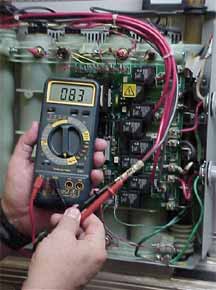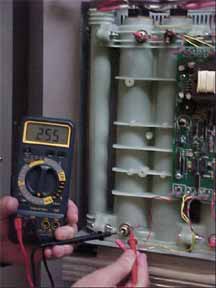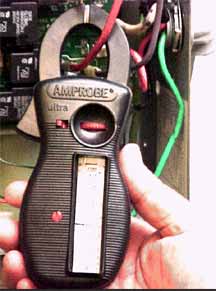Measuring Technique
Ohm (resistance) measurements are taken, with all power turned off to the heater, on the heating elements and the temperature sensors. Continuity checks can be done on the control wires, high limit switch, level detector circuit and leak detector circuit. Refer to Component Testing Table for details. The multi-meter should be dialed to ohms, on the appropriate scale to measure up to 20 ohms for the elements and on the appropriate scale to measure up to 500 ohms for the temperature sensors. The two multi-meter probes need to be placed on both connection terminals of the device in order to correctly measure the resistance (ohms). Refer to the Component Testing Table for the normal ohm readings of the elements in the various Seisco models. If no ohm reading or a decimal ohm value is read for any of these devices, then it is likely the device or it’s connecting control wire to the control board is open and needs to be corrected or replaced. However, the ohm meter must be checked again for proper dial setting and scale to be sure the reading was correct.
Below are to photos illustrating the use an ohm meter, or multi-meter, used to measure ohms (resistance) through a temperature sensor and a heating element. This check helps determine the values of these components as well as continuity.
 
Amp (current) measurements are taken while all of the power is on and the heater is running to determine if power is getting through from the board to the elements. Also, this check may also help determine, and lead to further checking for, an open heating element, a disconnected element wire, flow rate exceeding the heater’s capacity, or simply no power to the circuit being checked. The check is done by dialing the amp meter to read on the 100 amp scale.
 First the amp meter is clamped around a single red or black element wire traveling from the board to the element. With the heater running for a wide open flow, each heating element wire should read at or below the maximum amp rating of the circuit supply (See Component Testing Table for ratings). If the reading is zero amps, then further checks should be done to determine that the incoming power wires are in phase, the circuit breaker is turned on, the power wires are tight at the lugs, the heating elements are good and the wires are tightly connected on top of the heating element. If it is determined as a result of these checks that there is no amp flow getting through from the board to one or more the heating elements, the control board could be malfunctioning and need replacing. First the amp meter is clamped around a single red or black element wire traveling from the board to the element. With the heater running for a wide open flow, each heating element wire should read at or below the maximum amp rating of the circuit supply (See Component Testing Table for ratings). If the reading is zero amps, then further checks should be done to determine that the incoming power wires are in phase, the circuit breaker is turned on, the power wires are tight at the lugs, the heating elements are good and the wires are tightly connected on top of the heating element. If it is determined as a result of these checks that there is no amp flow getting through from the board to one or more the heating elements, the control board could be malfunctioning and need replacing.
Run hot water at a faucet with normal flow and measure the amperage as described above. If the amperage is modulating (jumping up and down) within the same range on each element wire, then the flow rate is within the heater’s capacity. If the amperage is steady and constant at the maximum amp rating for each element, then the flow rate may be exceeding the heater’s capacity.
Flow rates can easily be measured at a faucet, if necessary, by using a common one-gallon bucket or a similar container of known liquid capacity. Flow rates of new vanity faucets and kitchen faucets are rated for 2.5 gallons per minute. Mop sink faucets are high flow fixtures and are rated at 4 gpm or greater. If in doubt, the approximate flow rate can be determined by simply turning on the faucet in question to full flow, and timing how long it takes to fill the one gallon bucket. If it takes 20 seconds to fill the one gallon bucket, then the flow rate is 3 gallons per minute or 3 gpm. If it takes 15 seconds to fill the bucket, then the flow rate is 4 gpm. Simply divide 60 seconds (which is one minute) by the recorded time to fill the bucket to arrive at the flow rate.
Temperature readings of the inlet and outlet water to the heater can be determined with a common cooking or baking thermometer. The inlet water temperature should be measured at the nearest faucet to the heater, by simply turning on the cold water (not the hot) and placing the thermometer into the flow. For best results, let the water run for approximately one to two minutes before taking the reading. This allows purging of any ambient temperature water sitting in the lines. Inlet water temperatures can vary depending on geographical location and the type of water system, to the building.
The outlet or hot water output temperature of the heater needs to be measured at a faucet downstream from the heater. Also, a reading should be taken at the outlet pipe above the heater to verify that there is no mixing of hot and cold at the faucet or in the plumbing between the heater and the faucet. The thermometer can be placed on the metal connection above the outlet fitting (not on the plastic outlet fitting itself) to obtain a reading, or simply feel the pipe to determine if the heater is producing hot water. If the outlet pipe of the heater is hot, but the faucet downstream from the heater is not producing hot water (provided enough time was allowed to purge the lines of standing cold water), then there may be the need to check the plumbing lines or the faucet for possible ratio adjustments, mixing or simply for incorrect line connections.
Temperature adjustments can be made at the heater using the adjustable thermostat knob that is located on the left side of the control board (the protective heater cover must be removed to expose the control board). Typically, the factory calibrates the setting to the 3 o’clock position to provide approximately 120 degree F output temperature.
Caution; For new construction, most local building codes require that the maximum domestic hot water temperatures do not exceed 120 degrees F, to reduce the risk of scalding. Due to these liability issues, it is recommended to leave the temperature at the factory setting.
Most dishwashers have heating coils to heat the water to an effective cleaning temperature. The soap used for dishwashers and washing machines is designed to kill the bacteria. Therefore, it is not recommended to turn up the Seisco heater output temperature for dishwashers and washing machines.
Heaters used for standard applications, such as for domestic hot water, have a temperature range that can be adjusted with the thermostat knob from about 90 to 130 degree F. Turning the knob to the right (clockwise), increases the temperature output and turning the knob to the left (counterclockwise), decreases the output temperature of the heater.
It’s important to remember that tankless water heaters provide a continuous flow of hot water at the desired temperature. there is no reason to overheat the water, which causes excess mineral deposits in any water heater, just so that you can add cold water to cool it down. Take advantage of the benefits of your Seisco and operate it at as low a temperature as you wish to use for your normal hot water requirement.
Back to Top
|